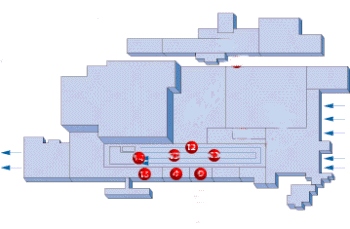
Automotive Intelligence - the web for automotive professionals and car enthusiasts
August 22, 2007
This Week:
-
Pebble Beach provided the stage for the all new Aston Martin DBS
-
GEM Zero Emission Vehicles winner of for Clean Air Leadership
-
Limited-edition of Lexus SC 430 made its debut at Pebble Beach Concours d'Elegance
-
Completely reworked Chevrolet Aveo will be presented in Frankfurt
-
C5 Airscape Concept gives an outlook of future Citroen C5 design
-
MINI John Cooper Works CHALLENGE, next season's MINI Challenge race car
-
All-New 2008 Honda Accord combines dynamic performance with fuel efficiency
-
Nissan will equip all future models with newly developed Fuel Efficiency Gauge
-
Volkswagen Group sets new record with 3.61 million car sales worldwide for first half year
© 1998 - 2007
Copyright &
Disclaimer
Automotive Intelligence,
www.autointell.com
All Rights Reserved .
For questions please contact
editor@autointell.net
|
Honda's Marysville Auto Plant celebrates 25th anniversary It's been nearly 25 years since Honda became the first Japanese company to build a car in the United States, and like the all-new 2008 Honda Accord, the Marysville Auto Plant has evolved into a wonder of technology.
The first Accord produced in America - a silver-gray sedan with the license plate "USA 001" -- came off the line on Nov. 1, 1982. It was enshrined in a museum to mark the achievement of Honda and its U.S. workforce. Today, the production of that first U.S. car is recognized as a turning point in American manufacturing. And the plant - where more than 8.8 million vehicles have been built - has been marked by continuous innovation, including more than $3.6 billion in new investments. "On the outside, the Marysville Auto Plant is 25 years old. But on the inside, our associates have used their passion and knowledge to keep their plant at the top of the global industry," said Akio Hamada, president of Honda of America Mfg. Inc. |
|
|
|
In the final two months of 1982, Honda turned out 968 Accords at Marysville. Today, the plant can build* 1,800 cars and light trucks in a single day, or 440,000 a year. Back then, the Accord was assembled using many imported parts, including the engine. Today, the plant builds the Accord, Accord Coupe, Acura TL cars and the Acura RDX sport utility vehicle. All of these vehicles receive their engines from the nearby Anna Engine Plant, the largest auto engine plant in North America. |
Of the 1.5 million vehicles Honda sold in the United States last year, nearly 80 percent were domestically made. All of the domestic cars and light trucks were equipped with U.S.-made engines as well as parts from a network of 610 North American suppliers - 525 of those located in 35 U.S. states.
The Marysville Auto Plant has evolved into a source of leadership and teaching -- what Honda calls a "mother plant" in its global system.
In fall 2008, the excitement that surrounded the birth of the Marysville plant will be repeated when construction is completed on Honda's newest assembly plant, in Greensburg, Ind.
The Greensburg plant will contain the ninth Honda vehicle line at six sites in North America. The other sites are at Marysville and East Liberty, Ohio; Alliston, Ontario; Lincoln, Ala.; and El Salto, Jalisco, Mexico.
Today, of the 27,000 Honda associates living in the United States, well over 20,000 are employed in manufacturing, engineering and research and development, mainly in Ohio, Alabama, North and South Carolina and California.
As a result of continued investment, every major process at the Marysville Auto Plant - known locally as "MAP" - has remained state of the art since it opened in 1982. Among the highlights:
Honda wasted no time with its first major MAP project -- the addition of a second assembly line in 1985. Capacity and efficiency projects followed, and tweaks and fine-tuning has never stopped.
Several years ago, the plant took its turn in the global Honda process called the New Manufacturing System, under which assembly plants were converted to flexible production. The body-welding shop converted from more-costly retooling to "re-teaching" flexible robots with sophisticated software to construct cars and light trucks of different body styles. The conversion saves time and millions of dollars, allows Honda to react quickly to changes in consumer demand, and contributes to workforce stability.
The all-new 2008 Honda Accord offers a glimpse into how MAP's continuous changes pay off. The new Accord is higher, wider and longer than the vehicle it replaced, and has more optional equipment and amenities. Yet, engineers at Honda of America and Honda R & D were able to design a car that has fewer parts and employs more ergonomic help for associates.
"Honda has always done things in a different way, and I think that has been the key to our success here and at the newer plants," Harpest said. "Our associates have proven themselves time and again to be up to new challenges, and we're confident the quality of the 2008 Accord will reflect their teamwork and know-how."
Clement D'Souza, engineering project leader for the 2008 Accord, oversaw a wide array of operational changes to take the new car to higher levels of quality and reliability.
"We were aiming to identify potential quality issues very early in the development stages, and design them out of existence," D'Souza said.
The result is a 2008 Accord that's not only engineered to please Honda's American customers, but which is intended to be exported to more than 30 countries.
In 1977, Honda announced that it would begin U.S. manufacturing with a motorcycle plant in Marysville. On Sept. 10, 1979, the first bike came off the line. The next day, Honda of America received this facsimile message from Tokyo headquarters: "Proceed with auto plant." The original USA 001 Accord is on display at the Henry Ford Museum in Dearborn, Mich.
Honda began U.S. sales operations in 1959, the company's first venture abroad. Honda's cumulative investments in U.S. operations exceeds $9 billion. Last year, the company purchased more than $17.6 billion in parts and materials from its 610 suppliers in North America.
*Using domestic and globally sourced parts
August 21, 2007
Photos: Honda
| .
Homepage News Companies Management Publications Events Guestbook Search . |
